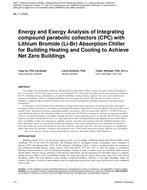Description
According to the Department of Energy, Building Energy Data Book (2009), commercial and residential buildings in the U.S. consume 39.9 % of the primary energy and contribute 39 % of the total CO2 emissions. In the operation of buildings, 41.8 % of building energy consumption is provided for building cooling, heating, domestic hot water, and ventilation for commercial buildings, while in residential buildings, this percentage increases to 58%. In order to achieve net zero buildings, significant effort should be focused on the research and development of building integrated renewable energy technologies.
In this paper, a solar thermal driven absorption cooling and heating technology is presented, and then analyzed for providing cooling and heating to a building, the Intelligent Workplace South Zone at Carnegie Mellon University. The system includes 30 m2 of proposed external compound parabolic concentrator with evacuated tubes (XCPC), a 16 kW (4 tons) twostage lithium bromide (Li-Br) absorption chiller for cooling and a 20 kW heat exchanger for heating. A compound parabolic collector can absorb both direct and diffuse sunlight and does not need tracking devices or controls. The XCPC heat transfer model is presented and integrated with a two-stage absorption chiller model in Engineering Equation Solver (EES). With a focus on building cooling, the temperature, enthalpy, entropy, mass flow rate, and mass fraction of lithium bromide in the solar absorption system are presented in steady state operation. The exergy destruction in each component is calculated. From the results, the exergy destructions for the solar collector, generator, absorber, and heat exchangers are significantly higher than those in evaporator, condenser and expansion valves. The overall energy and exegetic efficiency are calculated.
Citation: ASHRAE Conference Papers, Montreal, QC
Product Details
- Published:
- 2011
- Number of Pages:
- 9
- File Size:
- 1 file , 1.9 MB
- Product Code(s):
- D-ML-11-C022




